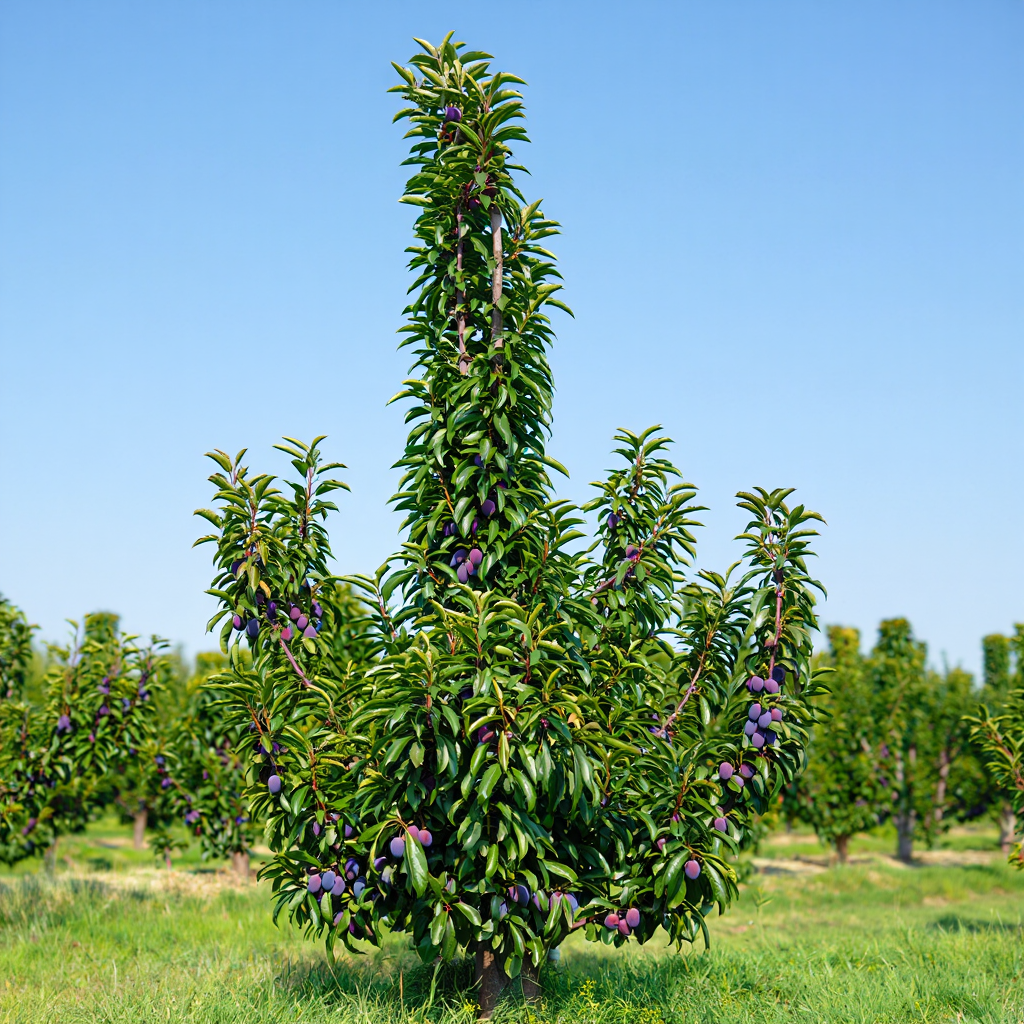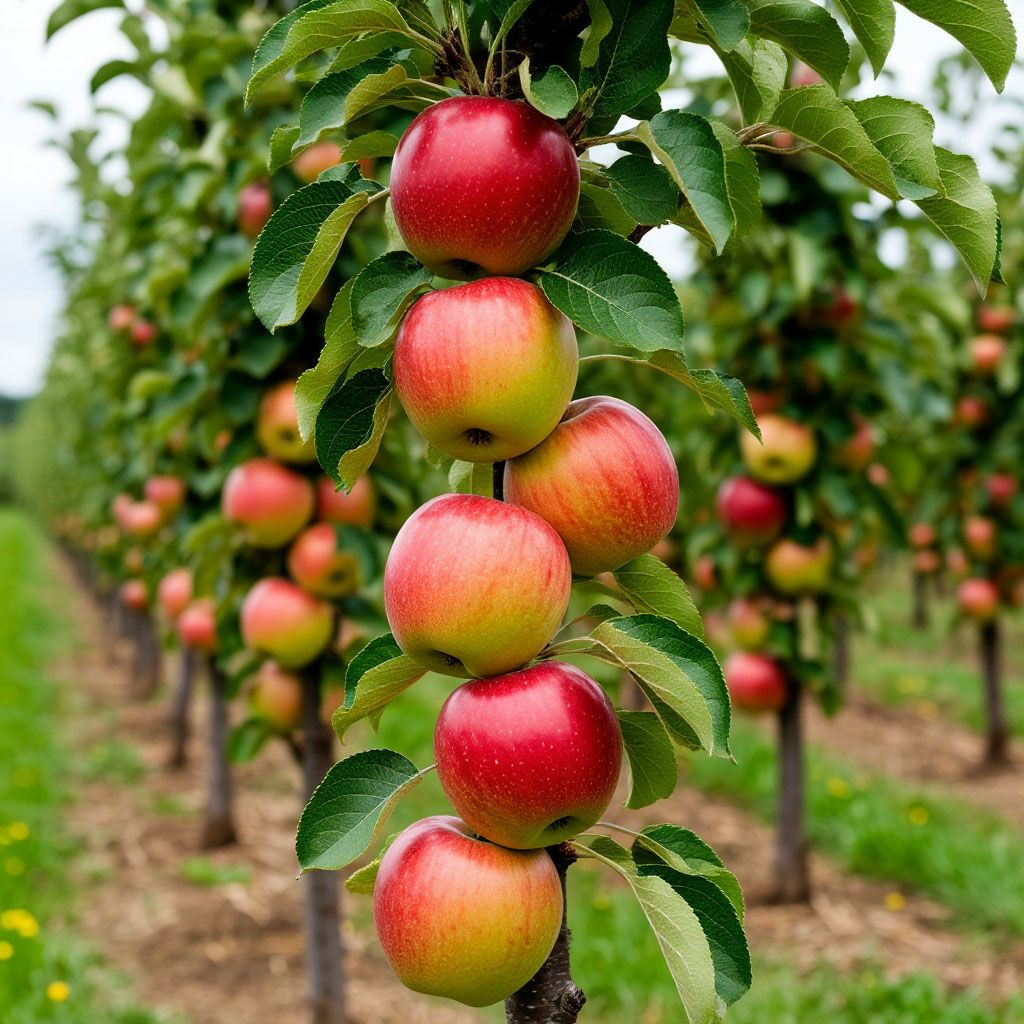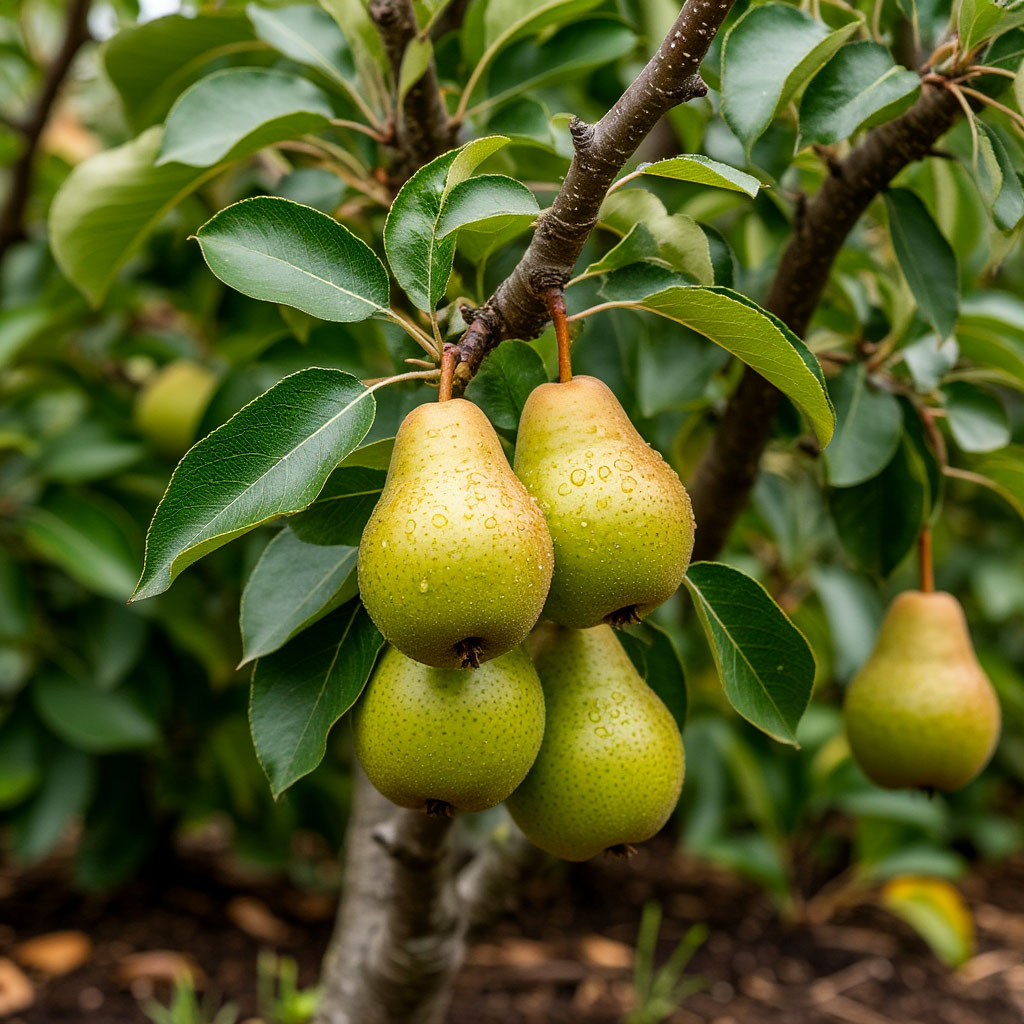Columnar plums are compact trees that are ideal for small plots. Their main advantage is a narrow crown and high yield with minimal maintenance. In this article, we will look at column-shaped plums (planting, care, popular varieties), tell you how to plant and protect them from diseases.
At the end you can download a brochure in which you’ll find a decision checklist, compact planting and container specs, training and pruning to keep a slender column, watering and feeding basics, a seasonal calendar, and a small planning worksheet.

Columnar plum varieties
Сolumnar plums varieties vary. Each of them has its own unique characteristics.
Imperial
It is characterized by sweet fruits with pink skin and high resistance to diseases. This variety of columnar plum is ideal for small gardens, as the tree grows compact – up to 2 meters in height. The fruit ripens in August and has a rich taste. This makes them an excellent choice for fresh consumption and preservation.
Blue Sweet
It has large purple plums with juicy flesh. This variety is valued for its high yield and pleasant dessert taste. The tree also has a compact size, which allows you to grow it even in a limited space. The fruit is great for making jams, compotes and drying.
Mirabella
A variety with a honey taste and aromatic fruits. In the case of columnar plums, these varieties are good in fresh form. The golden color of the fruit gives the garden an elegant look. The tree is resistant to temperature changes and bears good fruit in temperate climates.
Russian plum
It can withstand extreme cold, so it is suitable for regions with harsh winters. The fruits of this variety are medium-sized columnar plums, with a pleasant sourness, suitable for various culinary preparations.
When choosing a variety, it is better to take into account not only taste preferences, but also climatic conditions. For example, in the southern regions it is better to plant “Imperial” or “Blue Sweet”, while for the middle zone and northern regions “Mirabella” and “Russian” are more suitable. A properly selected variety is the key to a plentiful harvest and longevity of the tree.
How to plant columnar plums
Columnar plums require a special approach when planting. In order for the tree to take root well and produce a bountiful harvest in the future, it is important to follow several key rules.
Optimal landing time
The best time to plant is in early spring, as soon as the soil thaws. In the southern regions, autumn planting in September and October is also acceptable, but in this case the young tree will require careful shelter for the winter. Experts do not recommend summer planting – the heat reduces the chances of successful rooting, it is more likely that diseases of columnar plums will occur.
Seedling selection and preparation
Criteria for a quality seedling:
- Age 1-2 years.
- Height 70-100 cm.
- Well-developed root system.
- Smooth bark without damage.
- No signs of diseases.
Before planting, soak the roots for 6-12 hours in water. You can add a root formation stimulator (Kornevin, Heteroauxin).

Site selection and preparation
How to plant columnar plums so that there is always a harvest? Trees prefer sunny, wind-protected areas with light, fertile soil. Loam and sandy loam with neutral acidity are ideal. For 2-3 weeks before planting, the site should be dug up, adding humus and wood ash. It is important to ensure good drainage – stagnation of water is harmful to the root system.
How to plant columnar plums: technology
The answer to the question of how to plant columnar plums begins with an explanation of the features of the formation of the planting pit. It is prepared with a size of 60 × 50 cm. A drainage layer of crushed stone or broken bricks with a thickness of 15 cm is laid on the bottom. The upper layer of extracted earth is mixed with humus, superphosphate and wood ash. The seedling is placed on an earthen mound, carefully straightening the roots. After backfilling, the root neck should remain 3-5 cm above ground level. The planted tree is watered abundantly (20-30 liters of water) and the trunk circle is mulched.
Primary care
In the first month after planting, regular watering is important- 2-3 times a week. During spring planting, experts recommend removing most of the flowersso that the plant does not waste energy on fruiting, but directs them to rooting. In case of a threat of frost, the young tree should be covered with agrofibre.
Accurate knowledge of how to plant columnar plums correctly is the foundation for successful cultivation and harvesting. If you follow all the recommendations for 2-3 years, you can get the first harvest of compact, but surprisingly productive trees.
Care of columnar plums
After proper planting, columnar plums require systematic care. Consider all aspects of tree care throughout the year.
Irrigation mode
All varieties of columnar plums need moderate but regular watering:
- Young trees (1-3 years old) – 10-15 liters of water weekly.
- Adult plants – 20-30 liters every 10-14 days.
- During the period of fruit setting (June) and their ripening (July-August), watering is increased.
- In September, water-charging irrigation is carried out (40-50 liters per tree).
Special attention: the surface root system requires mulching (peat, compost, mown grass with a layer of 5-7 cm) to preserve moisture.
Top dressing by season
Food is brought in according to the following scheme:
Early spring (before budding):
- Urea or ammonium nitrate (20-30 g per tree).
- Organic infusions (mullein 1: 10, bird droppings 1: 20).
Before flowering:
- Complex mineral fertilizers (nitroammofoska 40 g).
- Foliar top dressing with boric acid (2 g per 10 liters of water).
During the fruiting period:
- Potash-phosphorous fertilizers (superphosphate 30 g + potassium sulfate 25 g).
- Wood ash (200 g per trunk circle).
In autumn (after leaf fall):
- Humus or compost (5-7 kg per tree).
- Phosphorous fertilizers to increase winter hardiness.
Wintering and protection
Preparation for winter includes:
- Cleaning of the trunk circle from plant residues
- Whitewashing of trunks (to protect against sunburn)
- Warming of the root zone (10-15 cm layer of mulch)
- Wrapping trunks with burlap or agrofibre (especially for young trees)
- Rodent protection (plastic nets or special repellents)
Features of fruiting
For stable yields:
- In the first year, 100% of the flowers are removed
- In the second year, leave 30-40% of the ovaries
- In the third year, the crop is normalized, leaving 15-20 fruits
- In subsequent years, the load is monitored (no more than 30-40 plums per tree)
Regular care based on these recommendations will allow you to get plentiful yields (8-12 kg per tree) for 15-17 years. Observe the consistency of all measures and respond in a timely manner to changes in the condition of plants.
Pruning of columnar trees
Columnar plums require a special pruning approach that differs from traditional plum trees. The peculiarity of these plants is a weak branching and compact shape, but without proper formation it is impossible to achieve stable fruiting. The first pruning is carried out during planting – this is an important part of caring for columnar plums, which allows you to direct the plant’s forces to the development of the root system.
The main principle of pruning is minimal intervention while preserving the natural shape. The central conductor is not pruned, as this disrupts the characteristic columnar growth. In the first 2-3 years, damaged and weak side shoots are removed, leaving no more than 3-4 strong branches 15-20 cm. long. The best time for forming pruning is early spring, before the sap flow begins, when all problem areas are clearly visible.
Starting from the 4th year, when the tree enters full fruiting, pruning of columnar plums becomes more intensive. Every year, all branches that cross and grow inside the crown, shoots that deviate from the main trunk by more than 45 degrees, are removed..
Fruiting in columnar varieties occurs on short fruit branches, so they need to be preserved. In summer, you can pinch too actively growing side shoots, leaving 2-3 leaves after the fruit bud.
Attention when caring for columnar plums is paid to sanitary pruning. In autumn, after leaf fall, be sure to remove all dry, diseased and damaged branches that can become a source of infection. All sections with a diameter of more than 1 cm are treated with garden brew or a special paste. For work, use a sharp, disinfected tool to minimize injury to the plant.

Diseases of columnar plums
Various tree diseases can significantly reduce the yield and even lead to the death of the tree. Consider the main diseases of columnar plums and methods of combating them.
Fungal diseases of columnar plums
Fungal infections are among the most common problems affecting columnar plum trees. These diseases develop rapidly in wet, cool conditions and can significantly reduce yields if not controlled in time. Early detection and proper treatment are essential for maintaining healthy trees and preventing the spread of infection.
Klasterosporiosis (punctured spotting)
It is manifested by brown spots on the leaves, which eventually fall out, forming characteristic holes. Depressed spots appear on the fruits, leading to their deformation. For treatment apply:
- 3% bordeaux liquid in early spring
- Horus or Skor fungicides during the growing season
- Removing and burning affected plant parts
Moniliosis (fruit rot)
A dangerous disease in which:
- Flowers and young shoots turn brown and wither
- The fruit is covered with grey spore bearing pads
Control measures:
- Spray with 1% Bordeaux mixture before and after flowering..
- The use of Abiga-Pik or Phytolavin preparations.
- Regular removal of mummified fetuses.
Rust
It is characterized by orange spots on the leaves that fall prematurely. For the treatment of columnar plum disease, the following procedures are performed:
- treatment with copper-containing preparations;
- removal of affected foliage;
- exclusion of the neighborhood with juniper-an intermediate host of the fungus.
Bacterial infections
Bacterial diseases are less common than fungal ones but often more dangerous. They spread quickly through wounds or damaged areas of the tree, especially during warm and humid weather. If left untreated, bacterial infections can lead to the death of entire branches or even the whole tree.
Bacterial burn
Similar diseases of columnar plums are manifested by blackening and twisting of the leaves, as after a fire.
Control measures:
- Cutting out affected branches and grabbing healthy tissue
- Treatment with antibiotics (Phytolavin, Ofloxacin)
- Disinfection of the tool after pruning
Gum treatment
It often occurs after winter damage or improper pruning:
- Streaks of clear or yellowish resin appear on the trunk.
- For treatment: cleaning the wound to healthy tissue, treatment with 1% copper sulfate.
- Garden vapour coating.
Preventive measures
To minimize the risk of diseases:
- Choose sustainable varieties when planting.
- Follow the planting scheme (do not thicken).
- Perform regular sanitary pruning.
- Collect and burn fallen leaves.
- Perform preventive treatments in early spring and late autumn.
- Apply balanced top dressing in a timely manner.
- Control the soil moisture, avoiding waterlogging.
Timely diagnosis and proper treatment of diseases of columnar plums will help to preserve the health of the plant and get stable yields. Remember that prevention is always more effective than dealing with an already developed disease.
Columnar plums (planting, care, variety selection and protection from diseases) will ensure the longevity and fruiting of the tree. Follow the recommendations on how to plant columnar plums, your garden will delight with delicious plums every year!
Take this with you to the garden — get the brochure: CD Columnar Plums — Mini Brochure (PDF).


